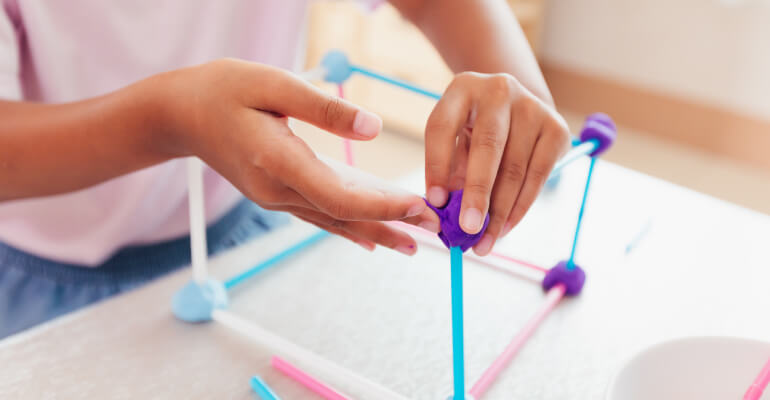The middle school years are a crucial time for students to develop their academic skills in all subjects, including the STEM subjects of science, technology, engineering, and mathematics. For students to fully develop a strong STEM identity, they need to participate in hands-on activities and projects that help them comprehensively understand key concepts.
By working on interactive STEM activities, students are more likely to understand how STEM is applicable to the real world. Hands-on activities are also great for students who struggle with traditional learning methods or students who have difficulty staying focused during standard lessons, as these STEM activities can provide an exciting break from typical classroom projects.
In this article, we break down the importance of STEM in middle school education and curate a list of great hands-on STEM activities for these middle grades.
For a dedicated STEM classroom kit, explore the STEM labs from Kid Spark Education, which include detailed curricula and all the ingredients you need to implement hands-on activities.

Importance of STEM in Middle School Education
In middle school, students begin to really embrace their strengths and passions, allowing them to envision what their potential academic and career paths could look like. Thus, it’s important for students at this age to get comprehensive exposure to STEM subjects and how those subjects connect to real-world problems, jobs, and opportunities.
Additionally, middle school STEM lessons can help students develop a scientific mind and thinking process, which they can then apply to other subjects and their own lives. Learning STEM has become as important as learning how to read, as basic STEM fluency is necessary for students to interact with the ever-evolving world around them. STEM-minded students can confidently approach the tech-driven future with ingenuity and passion.
12 Hands-On STEM Activities for Middle Schoolers
Not sure where to get started when it comes to bringing STEM to your classroom? Check out these twelve hands-on STEM activities for middle school students.
1. DIY Fidget Spinner
Fidget spinners are great examples of how physics works—and after learning about those key STEM concepts, your middle school students can put those ideas into practice by making their own DIY fidget spinners.
These fidget spinners can be created with any range of standard household materials, like cardboard, pennies, and toothpicks. Utilize fidget spinners to help students identify the key parts of the design and ask them to envision how they would make the item from scratch, keeping the physics concepts you taught them in mind.
For more thorough instructions, consider this lesson plan from Teachers Pay Teachers.
2. Magnetic Slime
Slime is a popular toy for middle school students, providing a fun sensory experience, but did you know that slime can actually be part of a great STEM lesson? Help your students create their own slime with a twist—it’s magnetic!
To do this, you’ll need the following supplies:
- Liquid starch
- Elmer’s glue
- Iron oxide powder
- Neodymium magnet
Mix ¼ cup of Elmer’s glue with 2 tablespoons of iron oxide powder, and blend thoroughly. Next, add ⅛ cup of liquid starch and stir. With a bit of kneading, your slime will rise and can be magnetized with your neodymium magnet. It’s important to note that you will need a strong magnet to see the effects.
This STEM project can be used to teach about principles of magnetism and how magnets are a part of the world around us, from the earth’s magnetic field to magnets as a part of engineering and technology. This project is also a great opportunity to practice safe STEM and lab practices. Students will likely have to regularly partake in labs in their future high school classes, so it’s highly beneficial for them to learn how to be safe now.
3. Water Filter Challenge
We all rely on water everyday, but we rarely think about the systems that keep that water clean and healthy for us. Challenge your middle school students to think about this, considering all the ways we use water and how that interacts with the water cycle.
Provide your students with different materials to choose from in order to filter dirty water that you create with dirt and other additives. The students will create their filters within empty plastic water bottles, cut in half and fit into each other.
Review the activity details from NASA’s Jet Propulsion Laboratory and tailor the project to the needs of your classroom.

4. STEM Scavenger Hunt
A STEM scavenger hunt is a great way to get students used to identifying different STEM concepts and applications in the real world around them. This can be done throughout the school, as a take-home activity, or as a project over a period of time.
After teaching about essential elements of STEM, have your students look for them in settings outside of the classroom. Create a list of STEM-related items to look, such as:
- Something that will float
- A repeating pattern
- A robot
- Item powered by batteries
- Something that uses gears
- Something that uses a lever
A STEM scavenger hunt is a wonderful way to expose students to a range of STEM concepts, and the earlier students are shown these concepts, the more likely they are to develop a strong STEM identity. For example, when students find a repeating pattern during this activity, they can then be taught about spatial skills and symmetry. Recognizing and understanding symmetry is a spatial skill as it requires perceiving and analyzing spatial patterns and relationships, and spatial skills have a strong link with performance in STEM fields.
Some scavenger hunt finds can be expanded into a later lesson. For example, once students find something that uses a lever, they can later link that experience to the Kid Spark Education Simple Machines lesson. During the lesson, students will build three different types of levers and consider the mechanical advantage of each. Whether you’re a Kid Spark educator or not, you can download the curriculum for free by creating an account and logging on here.
After the scavenger hunt, be sure to have the students share what they found with one another so they can see the full expanse of where STEM occurs.
5. Math Escape Room
With the right prep and planning, teachers can create a math escape room as a fun STEM challenge for middle school students. This “escape room” will utilize math problems as the primary clues, which need to be solved in the correct order to find a final answer.
For example, students may need to complete a worksheet of math problems and then use the numbers they get in their answers to correspond with a key, revealing a hidden message.
This hands-on activity can be completed in groups and does not require any additional materials to do.
6. Popsicle Stick Catapult
Challenge students with this hands-on STEM project! Using simple objects like popsicle sticks, rubber bands, and plastic spoons, your students will build their own mini catapult. Then, they’ll see how effective their catapults are at launching different objects, such as marshmallows, erasers, and paper balls.
Invite students to make adjustments to their catapults to see how that changes its performance. For example, adjust where the rubber bands are sitting and how many stacked popsicle sticks form the base of the catapult.
This activity can work well with lessons on physics, like when teaching Newton’s Laws of Motion and how energy is transferred.

7. Straw Buildings
Create some healthy competition while incorporating key engineering concepts with this middle school STEM activity! Give each student or group a set number of plastic straws plus tape or glue to connect the straws, and challenge them to build the tallest tower possible.
You can tie this lesson into various engineering processes and principles. Ask the students to examine what worked well and what didn’t, and then consider how those principles can be applied to the buildings, bridges, and other structures that surround them everyday.
8. Mini Coding Camp
Put a spin on coding lessons by making it a summer camp theme! This activity can work with any coding program, adding in competitions for different groups of students or overall goals. It can also be supplemented by offline coding activities.
There are many free coding activities available online developed for students, making this STEM lesson easy to implement with minimal work for the educator. Those free online coding programs include offerings from:
Be sure to research extracurricular coding camps in your area and online to share with students who particularly enjoy this aspect of learning STEM.
9. Lemon Battery
A lemon battery is a classic science experience for good reason! This hands-on STEM activity can help students better understand engineering principles as well as the basics of energy.
This project takes a few different supplies, including lemons, a copper coin, zinc electrodes, copper electrodes, lead wires with alligator clips, and a simple LED component. This project can also be done by using a multimeter. Follow the instructions from Science-U to get started.
Did you know that this battery can be recreated with other fruits and vegetables, too? Take the STEM challenge to the next level by bringing in oranges, limes, potatoes, tomatoes, cucumbers, apples, or bananas, and then seeing how those power sources stack up against the lemon.
10. Archimedes Screw
For this STEM project, we go way back into the past, which is perfect for students who love history or to teach alongside a history lesson about Ancient Greece. Be sure to spend time explaining how the Archimedes screw and similar devices still can be used today for tasks like wastewater removal.
The Archimedes screw is a positive-displacement pump that can seemingly defy gravity to move water. You can complete this STEM activity with a few simple materials, including a PVC pipe, vinyl tubing which you will wrap around the pipe, duct tape, two different height surfaces, and water.
Follow the project steps from Scientific American to implement this cool STEM challenge in your classroom.

11. Nature Walk
Similar to the STEM scavenger hunt, this STEM activity can be done in a few different formats, including as a summer activity or on a nice day where you want to get your middle school students out of the classroom. You don’t need to be near a park or large open space to do this, either, as nature crops up all over the place, including in the cracks of sidewalks.
You can set goals to look for on your nature walk, or you can let the students take the lead. The latter can be particularly useful when students are feeling burnt out or after standardized testing, allowing for a bit of a mental break while still focusing on STEM concepts. Most of all, this middle school STEM activity allows students to connect what they learn inside the classroom to the real world.
If you want to look for specific science elements, though, you can provide students with a list, including items like:
- Something with symmetry
- A part of the water cycle
- A seed pod
- Certain weather conditions
- An animal’s home (e.g. bird’s nest, beehive)
- A wind measurement from a hand-made anemometer
You can also take this opportunity to clean up any litter and trash in the area, emphasizing the importance of doing our part when it comes to pollution and the environment.
12. Describe Rocks Like a NASA Scientist
No matter where you and your students are based, you’ve definitely had a rock or two dragged into your classroom from the playground or elsewhere. With this STEM activity, your students will look at those rocks and more while envisioning what it could be like to pursue a career in STEM as a scientist.
This lesson comes from NASA’s Jet Propulsion Laboratory. You can start by focusing on the basics of geology and why it matters, and then teaching students how to use the correct scientific terms for the features of different rocks. Those terms include luster, cleavage, vesicles, inclusions, blebs, homogenous, and friable. The NASA lesson also includes two fun quizzes about identifying real rocks and “edible” rocks (images of candy bars to represent the different rock types).
Discover a Complete Middle School STEM Program with Kid Spark Education
While the above middle school STEM lessons are great supplements, a complete STEM education requires a thorough strategy and curriculum, like that provided by Kid Spark Education. Our middle school STEM labs are designed for grades six to eight, with different units focused on different principles.
Our middle school STEM program includes the following units:
- Kid Spark Basics
- Simple Machines
- Compound Machines
- Rapid Prototyping and 3D Printing
- Robotics and Coding 101
- Exploring Sensors
- Loops and Variables
- Integrated Engineering Challenges
A great STEM education is the key to a brighter future for students of all backgrounds, and, at Kid Spark Education, we’re committed to making that education a reality. Our middle school STEM kits include a science-backed curriculum that meets NGSS requirements, reusable engineering and robotic tools, complete lesson plans, and educator tools such as online training, grading rubrics, and step-by-step instructions.
To get started, explore our curriculum library, or contact our team today to learn more about our programs.
.png?width=1270&height=453&name=Copy%20of%20Kid%20Spark%20Logo%20(Horizontal%20-%20Full%20Color).png)